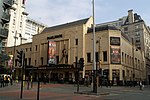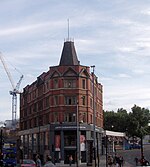Manchester Oxford Road railway station is a railway station in Manchester, England, at the junction of Whitworth Street West and Oxford Street. It opened in 1849 and was rebuilt in 1960. It is the second busiest of the four stations in Manchester city centre.
The station serves the southern part of Manchester city centre, the University of Manchester and Manchester Metropolitan University, on the line from Manchester Piccadilly westwards towards Warrington, Chester, Llandudno, Liverpool, Preston and Blackpool. Eastbound trains go beyond Piccadilly to Crewe, Leeds, Sheffield, Nottingham, Peterborough and Norwich. The station consists of four through platforms and one terminating bay platform.
The station sits on a Grade II listed viaduct, which was built in 1839 as part of the Manchester, South Junction and Altrincham Railway. To reduce load on this viaduct, the station unusually utilises laminated wood structures as opposed to masonry, concrete, iron or steel. English Heritage describes it as a "building of outstanding architectural quality and technological interest; one of the most dramatic stations in England". It was Grade II listed in 1995. Architectural critic Nikolaus Pevsner described the station as "one of the most remarkable and unusual stations in the country".
It has long been envisaged, since the Manchester Hub plan in 2009, that the station will be upgraded and, in October 2016, a Transport and Works Act application was submitted to extend platforms at the station as part of the wider Manchester Piccadilly and Manchester Oxford Road Capacity Scheme. As of 2019, this application remains active but has not been approved by government. As a key transition node for both north–south and east–west transpennine routes, it is a recognised bottleneck and is the most delayed major station in the United Kingdom according to a Which? study in 2018 with over three quarters of services failing to depart on time during peak hours. In an attempt to obligate the DfT to provide funding for the Oxford Road upgrade to improve punctuality, Network Rail declared the Castlefield Corridor 'congested' in September 2019.










